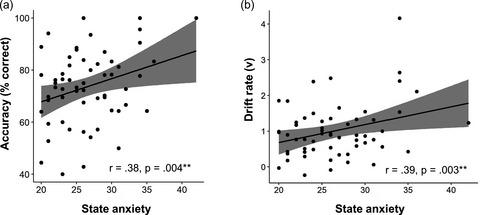Our official English website, www.x-mol.net, welcomes your
feedback! (Note: you will need to create a separate account there.)
Computational modelling of attentional bias towards threat in paediatric anxiety
Developmental Science ( IF 3.1 ) Pub Date : 2020-10-24 , DOI: 10.1111/desc.13055 Abigail Thompson 1 , Nikolaus Steinbeis 1
Developmental Science ( IF 3.1 ) Pub Date : 2020-10-24 , DOI: 10.1111/desc.13055 Abigail Thompson 1 , Nikolaus Steinbeis 1
Affiliation

|
Computational modelling can be used to precisely characterize the cognitive processes involved in attentional biases towards threat, yet so far has only been applied in the context of adult anxiety. Furthermore, studies investigating attentional biases in childhood anxiety have largely used tasks that conflate automatic and controlled attentional processes. By using a perceptual load paradigm, we separately investigate contributions from automatic and controlled processes to attentional biases towards negative stimuli and their association with paediatric anxiety. We also use computational modelling to investigate these mechanisms in children for the first time. In a sample of 60 children (aged 5‐11 years) we used a perceptual load task specifically adapted for children, in order to investigate attentional biases towards fearful (compared with happy and neutral) faces. Outcome measures were reaction time and percentage accuracy. We applied a drift diffusion model to investigate the precise cognitive mechanisms involved. The load effect was associated with significant differences in response time, accuracy and the diffusion modelling parameters drift rate and extra‐decisional time. Greater anxiety was associated with greater accuracy and the diffusion modelling parameter ‘drift rate’ on the fearful face trials. This was specific to the high load condition. These findings suggest that attentional biases towards fearful faces in childhood anxiety are driven by increased perceptual sensitivity towards fear in automatic attentional systems. Our findings from computational modelling suggest that current attention bias modification treatments should target perceptual encoding directly rather than processes occurring afterwards.
中文翻译:

小儿焦虑症注意偏向的计算模型
计算模型可用于精确表征与注意力集中在威胁倾向上有关的认知过程,但到目前为止,仅在成人焦虑的情况下才应用计算模型。此外,调查儿童焦虑中注意偏见的研究大量使用了将自动和受控注意过程混为一谈的任务。通过使用感知负荷范例,我们分别研究了自动过程和受控过程对注意力偏向负向刺激及其与小儿焦虑的关系的贡献。我们还首次使用计算模型来研究儿童的这些机制。在60名儿童(5-11岁)的样本中,我们使用了专门针对儿童的感知负荷任务,为了调查注意力在偏向恐惧(与快乐和中立)面孔上的偏见。结果指标是反应时间和准确度百分比。我们应用了漂移扩散模型来研究涉及的精确认知机制。负载效应与响应时间,准确性和扩散建模参数漂移率和额外决策时间的显着差异相关。担忧的面部试验中,更大的焦虑与更高的准确性以及扩散模型参数“漂移率”相关。这是特定于高负载条件的。这些发现表明,在儿童焦虑症中,对恐惧面孔的注意力偏向是由自动注意力系统对恐惧的感知敏感性增加所驱动的。
更新日期:2020-10-24
中文翻译:

小儿焦虑症注意偏向的计算模型
计算模型可用于精确表征与注意力集中在威胁倾向上有关的认知过程,但到目前为止,仅在成人焦虑的情况下才应用计算模型。此外,调查儿童焦虑中注意偏见的研究大量使用了将自动和受控注意过程混为一谈的任务。通过使用感知负荷范例,我们分别研究了自动过程和受控过程对注意力偏向负向刺激及其与小儿焦虑的关系的贡献。我们还首次使用计算模型来研究儿童的这些机制。在60名儿童(5-11岁)的样本中,我们使用了专门针对儿童的感知负荷任务,为了调查注意力在偏向恐惧(与快乐和中立)面孔上的偏见。结果指标是反应时间和准确度百分比。我们应用了漂移扩散模型来研究涉及的精确认知机制。负载效应与响应时间,准确性和扩散建模参数漂移率和额外决策时间的显着差异相关。担忧的面部试验中,更大的焦虑与更高的准确性以及扩散模型参数“漂移率”相关。这是特定于高负载条件的。这些发现表明,在儿童焦虑症中,对恐惧面孔的注意力偏向是由自动注意力系统对恐惧的感知敏感性增加所驱动的。











































 京公网安备 11010802027423号
京公网安备 11010802027423号